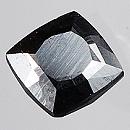|
Click on a letter above to view the list of gems. |
|
|
|
|
|
|
|
|
Tantalite-(Fe)
(formerly
Ferrotantalite) |
|
| | |
| Discovered in 1836; IMA status: Valid (pre-IMA; Grandfathered; renamed in 2008) | ||
|
| ||
|
Chemistry |
| ||||||||||||||||||||
|
| |||||||||||||||||||||
|
FeTa2O6 | |||||||||||||||||||||
|
|
Iron Tantalum Oxide | ||||||||||||||||||||
|
Molecular Weight: |
513.74 gm | ||||||||||||||||||||
|
Composition: |
| ||||||||||||||||||||
|
|
|||||||||||||||||||||
|
|
|||||||||||||||||||||
|
|
|
Classification |
|
|
| |
|
Oxides | |
|
4/D.18-50 | |
|
|
4 : OXIDES (Hydroxides, V[5,6] vanadates, arsenites, antimonites, bismuthites, sulfites, selenites, tellurites, iodates) |
|
Related to: |
Tantalite-(Fe)-Tantalite-(Mn) Series. Tantalite-(Fe)-Columbite-(Fe) Series. Dimorphous with Ferrotapiolite. |
|
Synonyms: |
Coltan, Columbite-Tantalite, Ferrotantalite, Siderotantalite |
|
|
|
|
Crystal Data |
|
|
|
|
|
Commonly as exsolution intergrowths with ferrotapiolite. |
|
|
None |
|
|
|
|
|
Physical Properties |
|
|
|
|
|
{100} Distinct, {010} less Distinct |
|
|
Irregular/Uneven, Sub-Conchoidal |
|
|
Brittle |
|
|
6.0 - 6.5 |
|
|
6.65 - 7.95 (g/cm3) |
|
|
None |
|
|
Not Radioactive |
|
|
Other: |
Paramagnetic |
|
|
|
|
Optical Properties |
|
|
|
|
|
Iron-Black; Reddish Brown in transmitted light; Gray in reflected light with Red to Reddish Brown internal reflections |
|
|
Opaque, translucent on thin edges |
|
|
Vitreous, Submetallic |
|
|
2.260 - 2.430 Biaxial ( - ) |
|
|
0.170 |
|
|
Relatively Strong; r < v |
|
|
|
|
|
Occurances |
|
|
|
|
|
Geological Setting: |
As an accessory and primary constituent of granite pegmatites. |
|
Common Associations: |
Ferrotapiolite |
|
Type Locality: |
Upper Bear Gulch, Tinton pegmatite District, Lawrence Co., South Dakota, USA |
|
Year Discovered: |
1836; IMA changed name from Ferrotantalite to Tantalite-(Fe) in 2008 |
|
View mineral photos: | |
|
|
|
|
More Information |
|
|
|
|
|
| |
|
|
|
|
Tantalite is also very closely related to Tapiolite. The two minerals have the same chemical composition, but different crystal structures; Orthorhombic for Tantalite and Tetragonal for Tapiolite. Tantalite is found as brown to black opaque crystals and Manganotantalite can be found as brown to red translucent to transparent crystals and is rarely available as faceted gems that can be very attractive. Some Tantalite specimens may show a bluish iridescence and have weak magnetism. Material
analyzed by microprobe from: Moss, Norway. At Spittal
an der Drau, Austria. In the Yellowknife district, Northwest
Territories, Canada. At Muhembe, Rwanda. From Nyanga,
Uganda. At Upper Bear Gulch, Lawrence County, South
Dakota, USA. |
|
|
We
have not photographed our Tantalite gems. Please
check back soon. |
